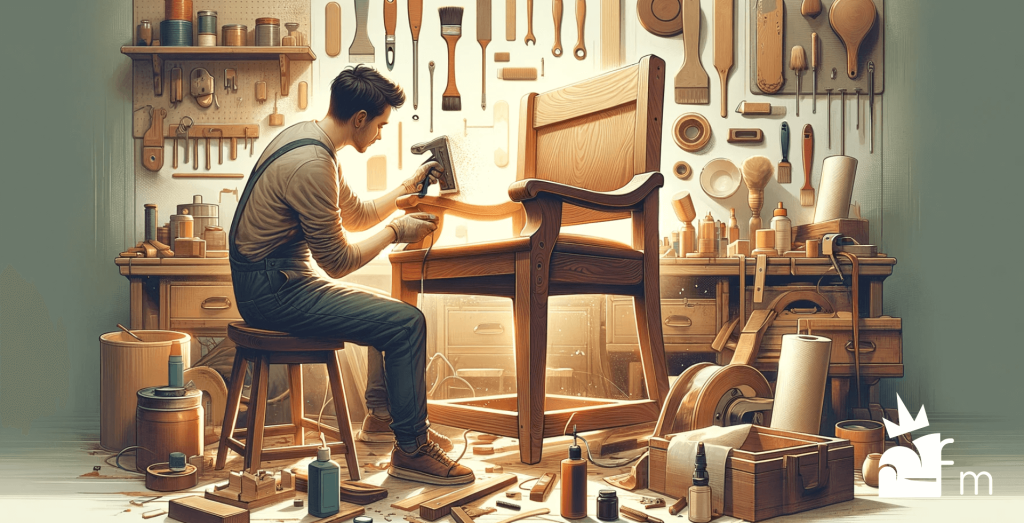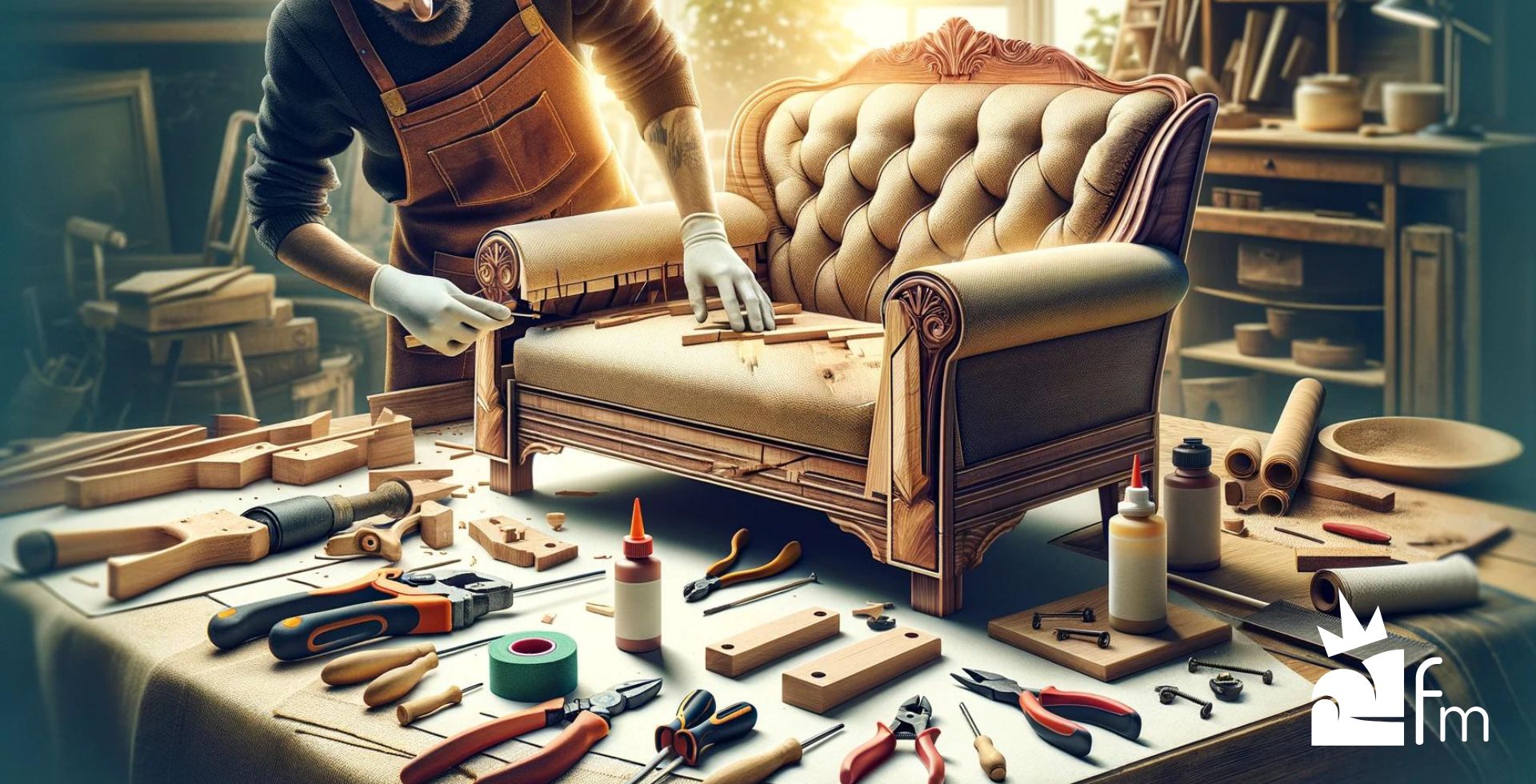After your living companions and digital devices, couches can be your best partner in your home. This furniture was there when you read, played games, watched TV, and bonded with your friends.
So, it’s hard to imagine a situation where your couch is broken for a single piece of wood and needs fixing. The problem becomes frustrating when the wood piece is inside the couch, Yep, unfathomable sadness!
But you don’t need to worry. Maybe a broken couch is bad; however, fixing it can’t be that bad. You need to figure out the right technique and tools to perfectly repair the damage and restore the couch to its former glory.
We will be glad to help you in this process. In this guide, we will share a 5 simple step-by-step guide to fix broken wood on a couch.
Let’s get going,
15 Tools You Will Need to Fix Wood Furniture
Before you start the work, make sure you have all the necessary tools close to you. Here is a list of things you will need,
- Screwdriver
- Sandpaper
- Wood Glue or Epoxy
- Clamps
- Hammer
- Nails or Screws
- Wood Filler
- Paint or Varnish
- Clean Cloth
- Measuring Tape
- Pencil or Chalk
- Saw
- Metal Brackets
- Safety Goggles
- Work Gloves
Remember, if you are facing a very simple problem, then you might not need all the tools mentioned here. Just the regular tools available in your house will do.
9 Steps to Fix Broken Wood in a Couch

Repairing broken wood in a couch can extend its life and save you the cost of buying a new one. The following is a straightforward guide to help you through the 9 steps to effectively fix broken wood in your couch.
Step 1: Identify broken areas
Begin by removing any cushions or covers from the couch to expose the wooden frame. Conduct a thorough examination, both visual and tactile, to locate the broken or weakened areas. Pay close attention to places that seem wobbly, or that produce creaking sounds when touched or gently pushed.
Step 2: Prepare the surface
Before you proceed, clean the surface of the affected areas with a damp cloth to remove any dirt or dust. After that, use medium-grit sandpaper to sand the broken or affected wood gently. This will facilitate better adhesive bonding.
Step 3: Apply adhesive
Choose a high-quality wood glue or epoxy that is suitable for furniture repairs. Apply this adhesive evenly over the sanded, clean surface of the broken areas, taking care to ensure a comprehensive application.
Step 4: Clamp the pieces
Once the adhesive is applied, align the broken pieces together as accurately as possible. Utilize strong wood clamps to hold them in place while the adhesive cures. The clamps should be tight but not overly so, as you don’t want to cause further damage.
Step 5: Reinforce the area
When the adhesive is fully cured, add additional support, such as screws or small wooden dowels, to reinforce the repair. Drill pilot holes before inserting screws to prevent splitting the wood. This added reinforcement ensures long-term stability.
Step 6: Sand the surface
After the reinforcements are in place and any additional adhesive has cured, it’s time to make the surface smooth. Use fine-grit sandpaper to carefully sand down the repaired area, removing any excess glue and preparing the wood for finishing.
Step 7: Apply finish
Select a finish that matches the rest of your couch, such as varnish or paint. Apply it with careful, even strokes, covering the repaired area completely. Allow sufficient time for the finish to dry before moving on to reassembly.
Step 8: Reassemble couch
At this stage, all repaired parts should be solid, and the finish should be dry. Go ahead and reattach any parts that were removed, such as legs or cushions, making sure they are securely fastened.
Step 9: Conduct final inspection
With everything reassembled, perform a comprehensive final inspection. Sit on the couch, move it slightly, and ensure that all parts are holding up well. Your couch should now be as good as new or close to it.
Discover How to Fix Your Chipped Wood with Expert’s Help
When Should You Seek a Professional’s Help?
It’s good that you know how to fix the wood inside your couch, it’s best that you should always be prepared to seek professional help. So, If you notice significant structural damage, such as extensive cracking or wood rot, it’s best to consult a professional for repair.
Additionally, if the damaged area bears heavy weight or if the couch is an antique or high-value piece, expert intervention ensures both safety and preservation of value. While DIY methods work well for minor issues, a professional’s skill and experience are irreplaceable for more complex or delicate tasks. Trusting a seasoned expert can provide peace of mind and long-term durability for your furniture.
FAQ on How to Fix Broken Wood in Couch
Can a cracked frame be repaired?
Yes, a cracked frame in furniture can often be repaired, extending the life of your piece and saving you the expense of a complete replacement. Early detection is crucial for a successful repair.
Methods such as epoxy filling, clamping, and additional bracing can offer a sturdy solution. However, the complexity of the repair may depend on the location of the crack and the load that the particular area is supposed to bear.
Which Glue Is Best for Fixing Wood?
When it comes to woodworking, especially furniture repair, a high-quality PVA-based wood glue is usually the best option. It offers a strong bond and is easy to work with. That said, the specific choice of glue can depend on factors like the type of wood, the location of the furniture, and environmental conditions. For example, if your furniture will be exposed to moisture, a waterproof epoxy might be more suitable.
How to repair cheap wood?
Contrary to popular belief, even cheaper or less durable wood types like particle boards can be effectively repaired. Using methods like filling with wood filler, sanding, and then painting or staining can breathe new life into low-cost wooden furniture.
Depending on the extent of the damage, reinforcement using screws or additional wooden supports can provide long-lasting results. Thus, repairing cheap wood is not only feasible but can be economically prudent.
Is wood in furniture replaceable?
Certainly, many components of wooden furniture can be replaced, particularly in modern, modular designs. Replacement parts can often be sourced from the manufacturer, or custom pieces can be crafted.
This approach is particularly useful for antiques or sentimental pieces, where the goal is to maintain the original character of the furniture while restoring its functionality and integrity.
What’s cheaper than wood?
If you’re looking to cut costs without compromising too much on aesthetics or functionality, materials like composite boards, plywood, or medium-density fiberboard (MDF) are excellent alternatives. These engineered materials are generally less expensive than solid hardwood but can offer comparable strength and can even be designed to mimic the look of natural wood.
Our Verdict
Addressing the issue of repairing broken wood in your couch goes beyond mere practicality; it’s an exercise in stewarding a valued asset. With the appropriate methodology and tools, a task that initially appears intimidating becomes an empowering project.
Not only will you yield immediate benefits in the form of functional furniture, but the experience will also equip you with indispensable skills that have broader applicability in home management.
Restoring furniture isn’t solely about fixing imperfections; it’s a matter of safeguarding the history and character of each piece.
Whether your focus is on a treasured antique or a contemporary piece, skilled restoration adds nuance and depth to your living space. The acquired competencies in material selection, woodworking, and finishing techniques will serve as long-term assets, enriching your domestic life in meaningful ways.
Have a nice day!

